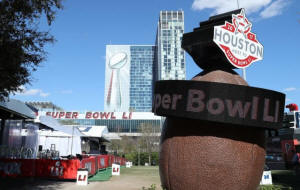|
Houston's downtown revamped in time for
Super Bowl
 Send a link to a friend
Send a link to a friend
 [February 01, 2017]
By Liz Hampton [February 01, 2017]
By Liz Hampton
HOUSTON (Reuters) - When Houston last
hosted the Super Bowl in 2004, the oil city's sleepy downtown lacked the
sizzle befitting the big game - and that prompted civic leaders to act.
This time, fans arriving for Sunday's American professional football
championship will discover a revamped downtown district with twice as
many residents, a renovated convention area and a plethora of food and
entertainment offerings.
The Texas megacity near the Gulf Coast, with a population of more than 6
million that makes it the United States' fifth-biggest metropolitan
area, is best known as a hub of the U.S. petroleum industry and for
NASA's famed Mission Control Center.
But those were not sufficient draws for travelers.
"We were losing convention business," said Peter McStravick, who oversaw
the downtown revitalization.
"Two of the reasons included a lack of hotel rooms within walking
distance (of the convention center) and a lack of destination appeal,"
said McStravick, who is chief development officer of Houston First, a
local government corporation.

City planners and business owners are eager to show off the
transformation dubbed Avenida Houston - Spanish for "Houston Avenue" -
which was led by groups such as Houston First.
The corporation spent some $175 million on projects such as a makeover
for the George R. Brown Convention Center, and helped attract new
developments to the area, including a nearby Marriott Marquis hotel,
which boasts 1,000 rooms and a Texas-shaped lazy river on the roof.
The area around Discovery Green, an urban park just outside the
convention center, will be home to a nine-day fan fest ahead of the
Super Bowl. Activities will include a virtual reality-enhanced
attraction to simulate a journey to Mars, built with the help of the
National Aeronautics and Space Administration.
Not all business is booming, however.
GreenStreet, a sleek shopping and entertainment center formerly known as
Houston Pavilions, has struggled to attract tenants and visitors. Many
of the bars and restaurants that sprang up next to the downtown baseball
park have failed, said Jon Taylor, who teaches a class about Houston at
the city's University of St. Thomas.
Taylor said there has also been criticism about parts of the Midtown
area near downtown, east of Houston's Main Street.
"There have been complaints about derelict buildings, vacant lots,
half-used old strip (mall) shopping centers, and nuisance issues with
the homeless population. Not very attractive to people who want to live
downtown," Taylor said.
But, overall, Taylor sees the changes as good for the city - and the
Super Bowl.
"You ended up with a situation in 2004, where they celebrated downtown,
but it was dead," he said. "I think that is going to change this time."
[to top of second column] |

A general view of the Houston Super Bowl football sculpture with the
Vince Lombardi Trophy image on the Marriott Marquis Houston at NFL
Live. Matthew Emmons-USA TODAY Sports

SUPER BOWL, SUPER DEADLINE
Although Sunday's game between the New England Patriots and the
Atlanta Falcons will take place at NRG Stadium several miles south
of downtown, most of the pregame events are in the city center.
The downtown renovations were going to happen regardless of the
Super Bowl, Houston First's McStravick said. But when Houston was
awarded this year's game in 2013, it gave the city a deadline.
"We said the Super Bowl was our goal because we had a chance to be
on the world stage," said Tom Segesta, general manager of the Four
Seasons Hotel Houston. "We saw this as an opportunity to transform
the hotel," which has undergone a multimillion-dollar facelift.
Organizations such as Houston First and business owners expect these
investments to pay off because of demographic changes.
Downtown's population of 5,400 is double that of 2004 and expected
to double again in the next three to four years, according to the
Houston Downtown Management District.
The population of "Greater Downtown" within a two-mile (3.2-km)
radius of the inner city has grown from 49,000 to 65,000 in the past
13 years, according to the district. The increase was fueled in part
by a tax break implemented in 2012 that offers developers a $15,000
rebate per residential unit.
Station Houston, a hub and support center for technology startups,
recently expanded into downtown and now assists over 170 early-stage
software entrepreneurs.

The organization has teamed up with companies ranging from oil
giants such as Royal Dutch Shell and Chevron Corp to local beer
maker Buffalo Bayou Brewing Co to attract new talent and technology
projects.
"We have more of our members who are moving into apartments right
here in downtown, taking the light rail to work," said John Reale,
Managing Director for Station Houston. "You see people on the
streets grabbing lunch or coffee. It's cool."
(Reporting by Liz Hampton; Editing by Daniel Trotta)
[© 2017 Thomson Reuters. All rights
reserved.]
Copyright 2017 Reuters. All rights reserved. This material may not be published,
broadcast, rewritten or redistributed. |